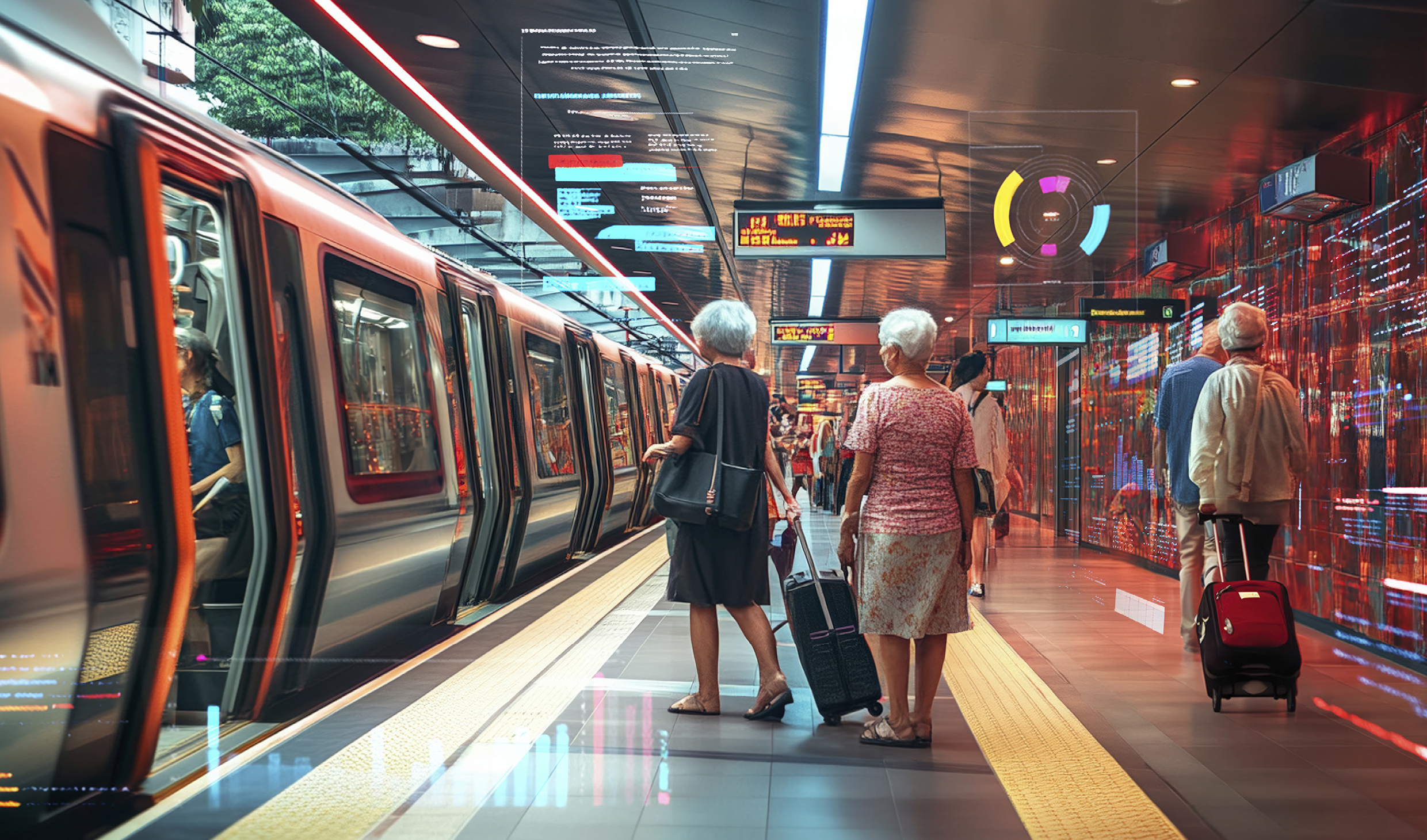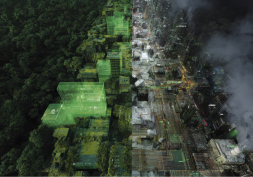Navigating the complexity of senior mobility
Follow CDE
PDF Download

A new data-driven model dissects the mobility patterns of older persons within urban transit systems, improving the understanding of their travel behaviours for more inclusive, accessible urban designs.
In the Netflix docuseries Live to 100: Secrets of the Blue Zones, National Geographic fellow Dan Buettner takes viewers on an odyssey through a handful of regions around the world, including Singapore, where people have significantly higher-than-average life expectancies.
Among the featured blue zones — Okinawa, Japan; Nicoya, Costa Rica; Ikaria, Greece; Sardinia, Italy; and Loma Linda, California — Singapore might seem like an outlier, with its glistening skyscrapers and bustling streets juxtaposed with the laidback, nature-rich environments of the other locations.
“It’s an engineered blue zone, instead of one that emerged organically like the other five,” Buettner says, noting how the city-state transitioned into an urban hub in the last few decades. “Cities have amazing power. If you have clear objectives, in just a handful of years, they can make complete transformations."
Singapore serves up many lessons in engineering longevity, one of which includes transforming transportation services to encourage urban mobility — crucial for older persons’ well-being and quality of life, as it helps them stay active, socially engaged and independent.
Associate Professor Liu Yang and her team created a data-driven model capable of dissecting the mobility patterns of older persons within urban transit systems.
Indeed, statistics show that urban transit has become the primary mode of transport for the elderly, supporting 60–90% of their daily trips in cities worldwide.
"To meet the mobility needs of seniors in ageing societies, it is crucial to understand where, when and why they travel within the transit system."
"To meet the mobility needs of seniors in ageing societies, it is crucial to understand where, when and why they travel within the transit system."
However, as the globe grapples with population ageing, urban transit systems will need to evolve to accommodate this demographic shift. “To meet the mobility needs of seniors in ageing societies, it is crucial to understand where, when and why they travel within the transit system,” says Associate Professor Liu Yang from the Department of Civil and Environmental Engineering and the Department of Industrial Systems Engineering and Management at the College of Design and Engineering, National University of Singapore.
To realise this goal, Assoc Prof Liu led a team to develop a data-driven model, based on real-world scenarios, that could answer the three ‘Ws’.
"To meet the mobility needs of seniors in ageing societies, it is crucial to understand where, when and why they travel within the transit system."
The team’s findings were published in IEEE Transactions on Intelligent Transportation Systems on 24 May 2023.
Understanding senior mobility for better urban planning
Building an efficient system means understanding the needs of those who use it regularly. When it comes to senior mobility, the focus should not only be on tracking where and when seniors travel, but also on uncovering the underlying reasons for their journeys. These insights — particularly the relationships between travel patterns and the placement of health and social facilities — are invaluable for city planners and policymakers. They provide the building blocks for creating urban environments that are both accessible and supportive of older persons’ well-being.
"By applying this technique to mobility data, we can treat each trip or travel sequence like a ‘document’ and each element of the trip, such as the destination, time of travel or duration, as a ‘word’."
"By applying this technique to mobility data, we can treat each trip or travel sequence like a ‘document’ and each element of the trip, such as the destination, time of travel or duration, as a ‘word’."
"By applying this technique to mobility data, we can treat each trip or travel sequence like a ‘document’ and each element of the trip, such as the destination, time of travel or duration, as a ‘word’."
Whether it’s traditional surveys or passively collected data from transit systems, current methods for studying senior mobility are limited by their small sample sizes, time-consuming processes and a lack of contextual richness that is required to understand why seniors choose specific travel routes and destinations. The challenge is further compounded by the complex and irregular travel patterns of older persons, which differ substantially from those of other age groups.
A proactive, data-driven alternative is needed. Assoc Prof Liu’s team developed a spatio-temporal travel pattern (STTP) model, which adapts methods from text mining — a process that scours large collections of text to tease out patterns. “By applying this technique to mobility data, we can treat each trip or travel sequence like a ‘document’ and each element of the trip, such as the destination, time of travel or duration, as a ‘word’,” explains Assoc Prof Liu.
Whether it’s traditional surveys or passively collected data from transit systems, current methods for studying senior mobility are limited by their small sample sizes, time-consuming processes and a lack of contextual richness that is required to understand why seniors choose specific travel routes and destinations. The challenge is further compounded by the complex and irregular travel patterns of older persons, which differ substantially from those of other age groups.
A proactive, data-driven alternative is needed. Assoc Prof Liu’s team developed a spatio-temporal travel pattern (STTP) model, which adapts methods from text mining — a process that scours large collections of text to tease out patterns. “By applying this technique to mobility data, we can treat each trip or travel sequence like a ‘document’ and each element of the trip, such as the destination, time of travel or duration, as a ‘word’,” explains Assoc Prof Liu.
“Incorporating these spatio-temporal covariates can help us estimate the relative importance of travel patterns across stations over time. This feature greatly improves the interpretability of activity recognition from passively collected mobility data.”
Through this novel approach, the model could reveal hidden patterns in how seniors travel — not just in terms of where and when, but also the underlying activities and behaviours driving these journeys.
The team applied the STTP model to transit data from Nanjing, China, focusing on the city’s urban rail system. Over several weeks, the researchers analysed millions of trips, discerning distinct travel patterns and associated activities. Indeed, they found that the seniors’ travel habits are closely linked to surrounding land use, such as proximity to parks, hospitals and residential areas. The study also split these travel patterns into short-, medium- and long-duration activities, each with unique implications for urban planning.
For instance, seniors frequently travelling to stations located near public parks might be doing so for morning exercises, social gatherings or leisure activities, typically lasting just a few hours. Understanding this trend allows planners to ensure that these green spaces are easily accessible via public transit, which in turn encourages seniors to remain active and socially connected. Interestingly, another pattern revealed that trips to stations near hospitals often occurred at specific times, such as after breakfast or lunch. This could mean that seniors schedule appointments during these times. Transit authorities could then adjust services to align with these periods, making visits to healthcare facilities less of a hassle for seniors.
Driving the development of senior-friendly cities
By turning raw mobility data into actionable insights, the team’s STTP model offers city planners and policymakers a robust, data-driven tool to enhance urban transit systems. It helps them understand how senior travel patterns are shaped by land use and activity preferences, while affording real-time tweaks through rolling forecasts. This ensures transit services remain accessible and responsive to evolving mobility needs — an increasingly essential capability as the globe gets ever greyer.
However, the researchers note that the model’s findings are based on data from one city in China, which may not capture the socio-economic nuances of other cities. To make the model more accurate and applicable, Assoc Prof Liu’s future research will involve studying more cities worldwide. The team also plans to integrate data from other travel modes, such as buses, taxis or ride-hailing systems, to account for complete trip chains and paint a more comprehensive picture of senior mobility.
Read More
View Our Publications ▏Back to Forging New Frontiers - October 2024 Issue
If you are interested to connect with us, email us at cdenews@nus.edu.sg









